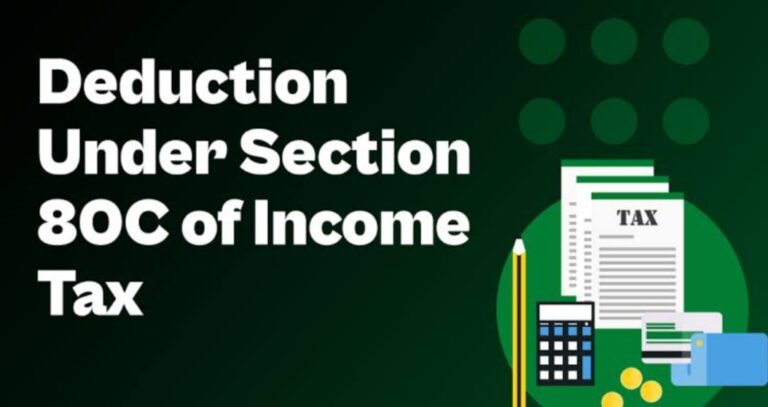Section 80C of the Income Tax Act, 1961, allows individual taxpayers and Hindu Undivided Families (HUFs) to claim deductions from their gross total income by investing or spending in specified avenues. The maximum deduction limit under Section 80C is ₹1.5 lakh per financial year.
✅ Eligible Investments and Expenses under Section 80C
Here’s a comprehensive list of common deductions:
🏦 Investment-Based Deductions
- Employee Provident Fund (EPF)
- Public Provident Fund (PPF)
- National Savings Certificate (NSC)
- 5-Year Fixed Deposit with Banks/Post Office
- Equity-Linked Saving Scheme (ELSS) – Tax-saving mutual funds
- Life Insurance Premium (for self, spouse, and children)
- Unit Linked Insurance Plans (ULIPs)
- Sukanya Samriddhi Yojana (for girl child)
- Senior Citizens Savings Scheme (SCSS)
- Post Office Time Deposit – 5 years
🏠 Deductions Related to Housing
- Principal repayment on home loan
- Stamp duty and registration charges for house purchase
📚 Education
- Tuition fees paid for up to two children (only school tuition fees, not donations or development fees)
⚠️ Important Points:
- The total deduction under Section 80C is capped at ₹1.5 lakh, even if your total eligible investment exceeds this.
- HUFs can also claim deduction under this section.
- The deduction is available only on actual payments made (not accrual basis) in the financial year.
- Some of these instruments (like PPF, ELSS) also offer long-term wealth creation.
🧮 Example:
If you invest:
- ₹60,000 in PPF
- ₹30,000 in ELSS
- ₹25,000 in Life Insurance
- ₹20,000 tuition fee for child
- ₹40,000 towards principal repayment of housing loan
Total eligible: ₹1,75,000
Deduction allowed under 80C: ₹1,50,000 only.
Details on Section 80CCC, 80CCD(1) and 80CCD(1B):
Here’s a detailed explanation of Sections 80CCC, 80CCD(1), and 80CCD(1B) of the Income Tax Act — all of which are related to retirement savings and pension plans, and are linked to but separate from Section 80C:
🔹 Section 80CCC – Contribution to Pension Funds
Applies to: Individuals (not HUFs)
Eligible Investments: Premium paid for annuity plans of any insurer (e.g., LIC’s Jeevan Akshay, Jeevan Nidhi) for receiving a pension.
- Maximum Deduction: ₹1.5 lakh (included in the overall ₹1.5 lakh limit of Section 80C)
- Conditions:
- The policy must be for pension/annuity only.
- Pension received from the plan is taxable in the year of receipt.
- Surrender value (if any) is also taxable.
🔹 Section 80CCD(1) – Employee/Individual Contribution to NPS
Applies to:
- Salaried employees contributing to NPS
- Self-employed individuals who opt for NPS
Deduction Limits:
- Employees: Up to 10% of salary (Basic + DA)
- Self-employed: Up to 20% of gross total income
📌 Subject to the combined limit of ₹1.5 lakh with Section 80C + 80CCC
🔹 Section 80CCD(1B) – Additional NPS Deduction
Introduced in Budget 2015 to give extra benefit to NPS subscribers.
- Extra Deduction: ₹50,000
- Over and above the ₹1.5 lakh limit under Section 80C/80CCC/80CCD(1)
- Only for contributions to NPS Tier I account
🟩 This means you can claim:
- ₹1.5 lakh under 80C + 80CCC + 80CCD(1)
- Plus ₹50,000 under 80CCD(1B)
👉 Total = ₹2 lakh maximum deduction
🔹 Section 80CCD(2) – Employer Contribution to NPS
Claimed by: Salaried employees only (not self-employed)
- Deduction Limit: Up to 10% of salary (Basic + DA); 14% if employer is Central Govt.
- Not part of the ₹1.5 lakh limit
- No upper monetary cap (limited to % of salary only)
This is a separate and additional deduction.
📊 Summary Table:
| Section | Applies to | Max Deduction | Included in ₹1.5L Limit? | Type |
|---|---|---|---|---|
| 80C | All (individuals, HUFs) | ₹1.5 lakh | Yes | General investments |
| 80CCC | Individuals only | ₹1.5 lakh | Yes (with 80C & 80CCD(1)) | Pension funds (LIC etc.) |
| 80CCD(1) | Employees/Self-employed | 10%/20% of income | Yes (with 80C + 80CCC) | NPS Tier I |
| 80CCD(1B) | Individuals | ₹50,000 | No – additional | NPS Tier I |
| 80CCD(2) | Salaried employees | 10%/14% of salary | No – additional | Employer’s NPS contribution |
